Abstract
The Dahongshan large-scale iron (Fe)–copper (Cu) polymetallic deposit is in the Proterozoic metallogenic domain on the western margin of the Yangtze Block. It is a typical representative of Fe-Cu polymetallic composite mineralization in the Kangdian area. The deposit comprises a group of layered orebodies formed by volcanic exhalation sedimentation and metamorphism, and a group of vein-like orebodies formed by hydrothermal superposition. The large-scale mapping of altered lithofacies in the deposit has resolved issues of weak links and unclear mineralization and alteration zoning of hydrothermal superimposed deposits within the study area. The mineralization type, hydrothermal alteration type and intensity, mineral assemblage, and mineral structure of the vein-type Cu polymetallic deposits during the hydrothermal superposition period are meticulously analyzed and studied. Finally, the zoning relationships of vein orebodies (mineralization) are summarized. On the basis of the results of the study of the distribution pattern of this mineral body, a mineralization alteration zoning model of the hydrothermal superposition period is constructed. The results show that the alteration is primarily silicification, carbonation, and chloritization, and the mineralization is chalcopyrite, bornite, chalcocite, and pyrite. The Dibadu anticline and the cutting layer faults and fractures strictly control the hydrothermal alteration zoning. The mineralization alteration zoning from the core to the flank is divided into coarse vein zone (I) → stockwork zone (II) → veinlet zone (III). The corresponding mineral assemblages are quartz–calcite–chalcocite–bornite–(native copper) (I) → calcite–dolomite–quartz–bornite–chalcopyrite–chlorite (II) → dolomite–quartz–chalcopyrite–(pyrite) (III), where the stockwork zone has the most substantial mineralization. The mineral assemblages of each alteration zone, the characteristics of rare earth elements of typical samples, and the test results on the fluid inclusions confirm that pH and Eh primarily control the zoning mechanism. This study has significance for deepening the understanding of the composite metallogenic system, guiding deep and peripheral prospecting, and providing significant enlightenment for the study of this type of deposit.
1. Introduction
The Kangdian area in the western margin of the Yangtze Block is a crucial Precambrian Fe-Cu polymetallic metallogenic belt in China. It has attracted much attention from scholars because of its large reserves and multistage composite mineralization.
The tectonic background, metallogenic age, metallogenic mechanism, and alteration characteristics of this area have always been fundamental scientific concerns for researchers [,,,]. The multistage mineralization of the deposit is significant, and it is rich in Fe, Cu, lead, zinc, nickel, lithium, and other metal elements [,]. Studies have revealed that the deposit exhibits submarine volcanic exhalation sedimentation, metamorphism, and hydrothermal superimposition. The primary layered orebodies and ore-bearing strata were formed during the early submarine volcanic exhalation–deposition of the deposit [,,]. Subsequently, metamorphism enriched the early ore-bearing layers [,,,]. Finally, the hydrothermal superposition event was experienced, forming cross-layer vein orebodies [,,,,].
Numerous studies have been conducted on the layered orebodies (mineralization) in the Dahongshan deposit, including potassium feldspathization, albitization, mica, and garnet petrochemical previous. The research has indicated that the ore-forming fluids exhibit medium–high temperature and high salinity characteristics [,,,,]. However, limited attention has been paid to the characteristics of veined Cu orebodies (mineralization) during the hydrothermal superposition period, as well as the zoning of mineralization–alteration and its underlying mechanisms. Investigating the vein orebodies (mineralization) is of theoretical significance for comprehending the metallogenic regularity, genesis, and prospecting potential of the deposit. In addition, it offers valuable insights for exploration and similar research on this deposit type.
This study used large-scale altered lithofacies mapping, microscopic observation, and rock alteration characteristics to analyze the mineralization alteration types, distribution patterns, and mineral assemblage characteristics of veined orebodies (mineralization) during hydrothermal superposition. Subsequently, the mineralization–alteration zoning of this orebody type was further delineated. By incorporating the geochemical characteristics of rare earth elements within each alteration zone, the regularity of the mineralization–alteration zoning was summarized, and the formation mechanism of the alteration zoning was analyzed. Finally, a mineralization–alteration zoning model of the deposit is proposed.
2. Deposit Geology
2.1. Regional and Geological Characteristics
The southwestern margin of the Yangtze Block is one of China’s significant nonferrous metal, rare metal, and nonmetallic mineral-resource-producing areas. The strata exposed in this area primarily comprise Archean and Proterozoic metamorphic rocks, such as migmatite, biotite hornblende schist, gneiss, granulite, and marble [], as well as Paleozoic to Cenozoic sedimentary rocks, such as conglomerate, mudstone, and shale [,]. The structure in the area is very developed, primarily NW, SN, and EW deep faults, such as Honghe, Luzhijiang, and Xiaojiang, and folds are widely developed in basement strata and caprocks, controlling the spatial distribution of the polymetallic deposits in the area, such as Lala [], Dongchuan [], Dahongshan [], Yinachang [], and some famous Fe-Cu deposits (Figure 1b).
The magmatic activity in the studied region is frequent and exhibits multistage characteristics, which can be roughly divided into four stages: (1) from the late Precambrian to the early Paleozoic, the primary rocks are tuff, metamorphic gabbro, and diabase, followed by metamorphic basic rocks and granite [,,,]; (2) from the late Early Paleozoic to the Middle Paleozoic, the predominant rocks are gabbro, diabase, peridotite, and serpentinite []; (3) from the Middle Paleozoic to the Late Paleozoic, prevalent rocks include plagioclase amphibolite, peridotite, and orthoclase amphibolite; (4) from the late Paleozoic to the Neogene, the region is characterized by granite and ultrabasic rocks [,,]. The later regional and hydrothermal metamorphism modified the rocks.
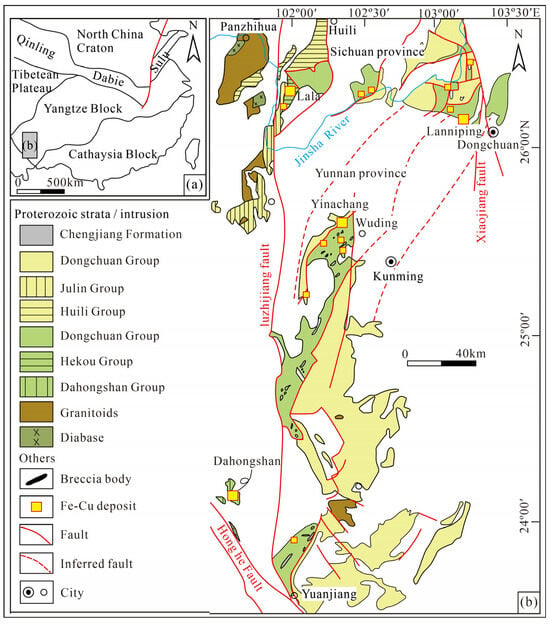
Figure 1.
(a) Simplified tectonic map showing the study area in the Yangtze Block; (b) geological map of Precambrian strata and Neoproterozoic intrusions in the Kangdian region, SW China, showing the distribution of Proterozoic Fe–Cu deposits (modified from Wu et al., 1990 []; Zhao and Zhou []; Su []).
2.2. Geology of the Dahongshan Mining Area
The mining area is in Gasa Town, Central Yunnan. It is in the southwestern margin of the Yangtze Block and the clamping part of the Honghe and the Luzhijiang faults. It is the largest Fe-Cu polymetallic deposit in Central Yunnan. The deposit is composed of layered orebodies formed by volcanic exhalation sedimentation metamorphism and veined orebodies formed by hydrothermal superposition. The exposed strata of the deposit, from old to new, are the Archean Dibadu Formation (Ard) (strong metamorphic migmatite and schist), which is typically angular unconformity or pseudo-conformity connecting with the overlying strata. The Early Proterozoic Dahongshan Group, from old to new, includes the Laochanghe (Pt1dl), Manganghe (Pt1dm), Hongshan (Pt1dh), Feiweihe (Pt1df), and Potou (Pt1dp) formations. The Manganghe Formation is dominated by abyssal submarine volcanic eruption sedimentary formation [], divided into four lithologic sections from the bottom to the top, which are primarily hornblende sodium-feldspar schist (Pt1dm1), garnet hornblende sodium-feldspar schist (Pt1dm2), garnet hornblende/biotite schist intercalated with sodium tuff (Pt1dm3), and pillared dolomite marble (Pt1dm4). Pt1dm3 is the primary occurrence horizon of layered Cu deposits []. The sandstones of the Upper Triassic Ganhaizi (T3g) and Shezi (T3s) formations are in the Dahongshan Group and exhibit angular unconformity contact with the underlying strata (Figure 2) [,]. The quaternary residual slope layer (Q) is distributed in the valley and valley slope area within the mining area.
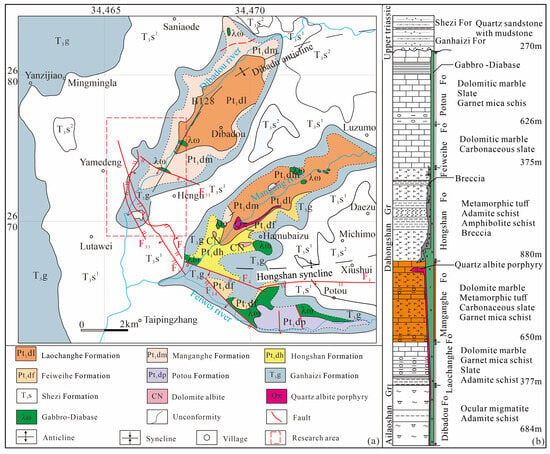
Figure 2.
(a) Geological map of the Dahongshan deposit (modified from Jin et al. []); (b) stratum histogram (modified from Qian and Shen []).
The Dahongshan mining area exhibits a highly intricate geological structure, predominantly characterized by folds and faults. The strikes are EW, SN, NE and NW, among which the NW and NE strikes are the most developed, and the multistage activity characteristics are clear. The folds are mostly Dibadu anticline. The NW faults F3, F31, and F5 and Dibadu anticline jointly control the Fe and Cu orebody distribution in the area (Figure 2a).
The magmatic rocks are well developed in the mining area, and the metamorphic tuff is the ore-forming parent rock. Furthermore, the area contains a small amount of sedimentary metamorphic schist (garnet mica schist). Intrusive rocks mainly include quartz albite porphyry, gabbro diabase, quartz albite dolomite, and diabase after mineralization [,,,,].
The deposit primarily develops I, II, III, and VI orebodies; the I orebody is the largest. The deposit contains 458 Mt, 41% Fe, and a large amount of Au (16 t), Ag (141 t), Co (1156 t), and Pd + Pt (2.1 t) (more details can be found in Zhao et al., 2017 []). The I3 orebody was selected for study, and it has an average Cu content of 0.76%. The average thickness of the orebody is 9.43 m. The orebody is hosted in metamorphic tuff. Bounded by the B128 line, the orebody in the west is NNW-trending and in the east NWW-trending, with an overall tendency of S.
3. Sample Collection and Test Methods
Lithofacies of different middle roadways in the Dahongshan mining area were recorded, and large-scale altered lithofacies mapping was conducted. The specific method is shown in Han (2005) [], with a total length of more than 2 km. The deposit was analyzed according to the characteristics of the mineral paragenetic assemblage, alteration type, and microscopic observation.
Quartz samples from different stages of the hydrothermal superposition period of the Dahongshan deposit were collected to study the geological fluid. The samples were evaluated in the Fluid Inclusion Laboratory of Kunming University of Science and Technology using the British Linkam THMSG-600 (Linkam Scientific Instruments, Redhill, UK). The theoretical operating temperature range of the instrument is −196 °C~600 °C. When the experimental temperature is −196~31 °C, the error is ±0.2 °C. When the experimental temperature is >100 °C, the error is ±2 °C. The salinity of the NaCl–H2O phase inclusions was calculated using the Bodnar (1993) [] equation.
A total of 89 fresh samples were collected from the structural fracture zone of each geological point in the Dahongshan mining area, including 83 samples at level 140, 3 samples at level 280, 2 samples at level 260, and 1 sample at level 360. Each sample weighed 1~2 kg, and all were ground to a 200 mesh size. The samples were evaluated using inductively coupled plasma-mass spectrometry (instrument: 7700X, Agilent Technologies, Santa Clara, CA, USA) in the Northwest Mineral Geological Testing Center of Nonferrous Metals, and the analysis accuracy was ≥10%. The experimental process and analysis procedure are described by Qi et al. (2000) [] and Gong et al. (2020) [].
4. Mineralization and Alteration
According to pyrite Re-Os (1026 ± 22 Ma) in quartz veins (Zhao et al. []), pyrite Re-Os (1026 ± 15 Ma) in quartz–calcite sulfide veins (Su []), and chalcopyrite Re-Os (1115 ± 28 Ma) in sulfide quartz veins cutting through layered orebodies (Jin et al. []), the research shows that the Dahongshan vein orebodies were formed during the Xiaoheqing–Manyingou stage (Glenville Orogeny, Rodinia supercontinent cycle). Disseminated–massive-vein chalcopyrite (Cp), bornite (Bn), chalcocite (Cc), native copper (Ccp), and pyrite (Py) developed [,,,,]. Mineralization is related to fault and hydrothermal activities. The Dibadu anticline and fault structure strictly controlled the mineralization, and it was produced in different lithologies, partially enriched or cut through the early layered orebodies, and the mineralization types were diverse (Figure 3). The alteration was primarily disseminated-plaque-vein silicification, dolomite (Dol), calcite (Cal), and chlorite (Chl).
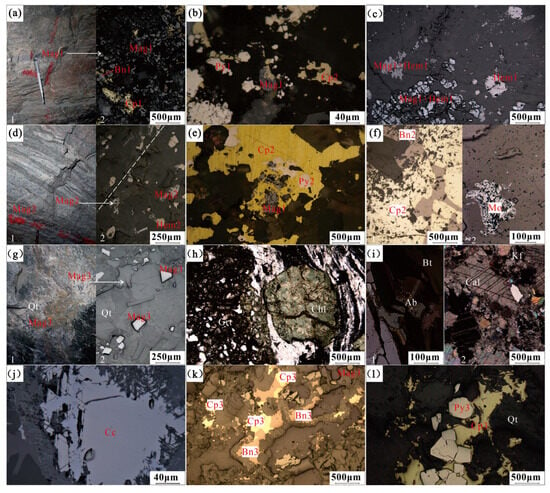
Figure 3.
Typical minerals and microphotographs of Dahongshan: (a) M1 and its microscopic characteristics; (b) altered granular pyrite and metamorphic hydrothermal chalcopyrite; (c) M1 was replaced by hematite; (d) orientated magnetite in the metamorphic hydrothermal period; (e) altered granular Py2 metasomatized by Cp2; (f) Cp2, Bn2, and Mo in metamorphic period; (g) acicular M3 in the metamorphic hydrothermal period, which is semiautomorphic–automorphic under the microscope; (h) early garnet was replaced by green mud; (i) early formed albite, potassium feldspar, and biotite; (j) granular chalcocite formed during hydrothermal superimposition; (k) vein chalcopyrite and bornite formed by the hydrothermal stack; (l) semiautomorphic–automorphic pyrite and allotriomorphic chalcopyrite. (Mag = magnetite; Hem = hematite; Cp = chalcopyrite; Py = pyrite; Bn = bornite; Cc = chalcocite; Mo = molybdenite; Grt = garnet; Bt = biotite; Ab = albite; Kf = K-feldspar; Qt = quartz; Cal = calcite; Chl = chlorite).
4.1. Mineralized Types
On the basis of the results of the detailed study of Cu orebodies and their main ore-bearing rocks in multiple planar tunnels in the Dahongshan mining area, magnetite (M) is the primary mineral that formed in the first two stages. According to its form of occurrence and microscopic characteristics, it can be divided into three categories: e(M1) is a product of the volcanic exhalation sedimentary period, and (M2) and (M3) are products of the metamorphic hydrothermal period.
M1: The dolomite-bearing metasodium tuff and garnet-bearing biotite schist exhibit a fine-grained, laminated–banded structure along the bedding plane. Under the microscope, the surface of these rocks appeared rough (Figure 3a).
M2: The gray–white dolomite-bearing metasodium tuff typically contains granular magnetite with a particle size of 0.3–0.7 cm. During metamorphism, the magnetite displays a directional distribution, and some of it is observed to flow around the garnet (Figure 3d).
M3: This type of magnetite is primarily found at the contact edge between quartz and the surrounding rock in the tensile tectonic belt, or within carbonate clusters. The magnetite has a needle-like morphology and is coproduced with the breccia of the surrounding rock. Under the microscope, it exhibits a semiautomorphic to automorphic granular structure (Figure 3g).
Hematite frequently metasomatizes M1 and M2 and is directional(Figure 3c,d(2)); however, M3 has not been metasomatized.
The chalcopyrite and bornite in the first and second periods are lamellar-disseminated, with a rough surface structure observed using a microscope (Figure 3b,e,f). They are found in the metamorphic sodic tuff and biotite schist of the Manganghe and Hongshan formations, forming a layered orebody with a rough surface structure. This study primarily involves the third period (i.e., hydrothermal superimposition), which can be divided into the first (I) to third (III) stages (Figure 4).
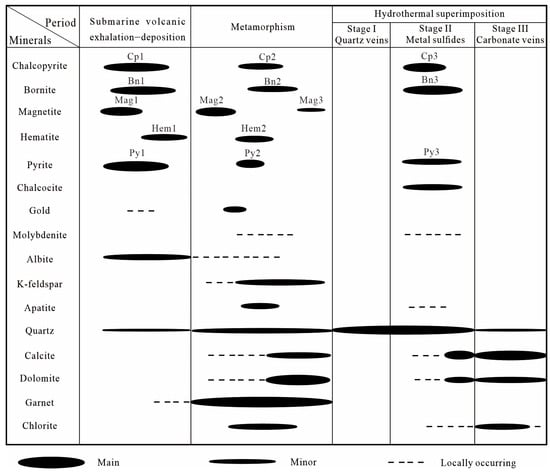
Figure 4.
A simplified paragenetic sequence of mineralization and alteration in the Dahongshan Formation.
Without special instructions, the minerals in the following paragraphs refer to the first to third stages (hydrothermal superimposition). Chalcopyrite and bornite are spotted and veined in the shear tensile (torsional) fault zone, associated with quartz (Qt)–dolomite–calcite, and dominated by filling and metasomatism, and the two mineralizations are frequently produced together (Figure 3k). The chalcocite is disseminated–veined in the bedding plane and fault zone of metasodium tuff, and it often coexists with calcite–quartz veins. It is irregularly granular under the microscope, and joints can be observed (Figure 3j). Native copper is only observed in the veinlet-star-like clip and chalcocite at the southwest end of the B128 line. Pyrite (Py) is closely associated with vein chalcopyrite, and they frequently coexist. Under the microscope, pyrite exhibits a semiautomorphic to automorphic granular structure (Figure 3l).
4.2. Alteration Types
In the hydrothermal superposition period of the mining area, silicification, carbonation, chloritization, and other alterations can be observed to be distributed in the ore-bearing structural belt as disseminated, agglomerated, and veined (Figure 5).

Figure 5.
Mineralization–alteration characteristics and alteration microphotographs of Dahongshan: (a) DG-32 cut quartz coarse vein; (b) DM-122 network vein silicification and carbonation; (c) vein carbonate and silicification in marble; (d) vein chalcocite and bornite mineralization in the coarse vein zone; (e) bulky-vein bornite and chalcopyrite mineralization in quartz veins containing calcite and in contact with the surrounding rocks in the fault zone; (f) spotted chalcopyrite and bornite in vein carbonation and silicification; (g) vein chlorite veinlet chalcopyrite mineralization in and around the quartz vein; (h) a specimen of porphyritic-veined chalcopyrite, bornite and veined chlorite. (i) Vein chlorite and granular calcite, silicification. (j) Microscopic granular quartz and irregular granular calcite and diamond dolomite. (k) Chalcopyrite encloses granular bornite. (l) Network vein chlorite and bornite mineralization on quartz. (Cc = chalcocite; Py = pyrite; Cp = chalcopyrite; Bn = bornite; Qt = quartz; Cal = calcite; Dol = dolomite; Chl = chlorite).
4.2.1. Silicification
Silicification is one of the most developed alteration types in the mining area, closely related to Cu mineralization in the hydrothermal superposition period, with vein mass, and primarily filled in the cutting layer and interlayer fracture. The quartz in the core of the Dibadu anticline is the largest, is frequently symbiotic with chalcocite and bornite, and is granular under the microscope (Figure 5).
H4SiO4 <==> SiO2 + 2H2O
(1) The formation of quartz [].
4.2.2. Carbonatation
The carbonation is generally developed in this deposit, which is primarily beige or grayish white calcite and dolomite. It is typically distributed in patchy, reticular, veined, and lenticular forms in the shear layer, bedding tensile (torsional) fault zone, and the intersection of faults. Those that are frequently produced with quartz veins are filled in the fault zones and joint veins in a stockwork vein–vein shape (Figure 5a–c). Disseminated, spotted-vein chalcocite, bornite, and chalcopyrite are frequently developed in the veins or in contact with the surrounding rocks (Figure 5d,e,h), and a small amount of pyrite can be seen (Figure 5f).
4.2.3. Chloritization
Chlorite typically occurs in vein-like or irregular forms, distributed on the surfaces of milky-white quartz and yellowish-brown calcite-quartz veins or in contact with the surrounding rocks (Figure 5g,h). The chlorite is closely related to Cu mineralization and frequently coexists with chalcopyrite and bornite. Under the microscope, the chlorite appears reticular (Figure 5i,l).
5. Results and Analysis
The Cu content in the tectonites of 140 horizontal faults was calculated (Table 1). The Cu content in the core of the Dibadu anticline (B128 line) and the nearby tectonites was 11.63~51,900.00 × 10−6 (avg. 2582.95 × 10−6). The Cu content of the tectonic rock in the flank of the Dibadu anticline was 26.67~4000 × 10−6 (avg. 510.05 × 10−6).

Table 1.
Copper content in different parts of the fault tectonite in the 140-level Dibadu anticline.
5.1. Alteration Zone Division
The altered lithofacies formed in the process of hydrothermal mineralization can reflect different physical and chemical conditions, and different mineral assemblages reflect different physical and chemical conditions. The mineral assemblages and characteristics in the different alteration zones indicate the occurrence of orebodies, and the relationship between mineralization and alteration is intuitively reflected by establishing the mineralization and alteration variations [,,,,,].
The northwest side of the Dibadu anticline to the southwest side is chalcocite + bornite + (native copper) → bornite + chalcopyrite → chalcopyrite + pyrite. The vein mineral zoning that formed during the hydrothermal superposition period of Dahongshan is highly similar to the metal zoning of porphyry Cu minerals; however, Dahongshan does not belong to porphyry Cu deposits. All these zoning rules may be widespread in the formation of sulfide Cu deposits.
5.1.1. Coarse Vein Zone (I)
The Dibadu anticline and faults control the coarse vein zone. This belt is primarily exposed near the turning end of the Dibadu anticline (B128 line). The mineralization assemblage comprises bornite, chalcocite, and (native copper), and the surrounding rock is metasodium tuff and marble. The cut layer is fractured, and the bandwidth is >20 cm. A large amount of quartz and a small amount of calcite are filled in the zone. Disseminated–veined bornite and chalcocite are occasionally found in the contact area between the vein and the surrounding rock. The alteration in the zone is primarily vein silicification and a small amount of carbonation. The silicification is the strongest, but the carbonation is weak, and the mineralization is weaker than the stockwork zone (Figure 6e,i,j).
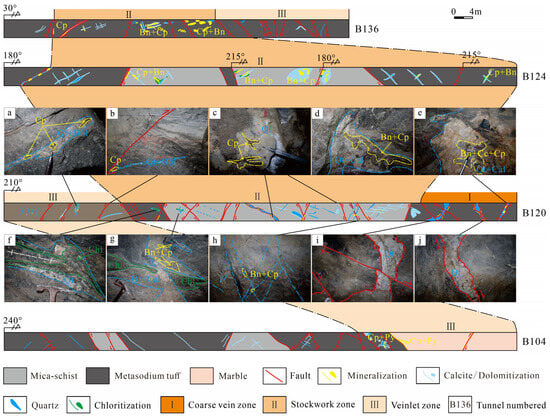
Figure 6.
The 140-level tunnel catalog section (part). (a) Cp in the veinlet Qt + Dol in the veinlet zone; (b) Faint Cp; (c) Vein Cp in stockwork zone; (d) Vein Cp and Bn in stockwork zone; (e) Qt + Cal package block Bn + Cc + Cp; (f) Vein Qt + Chl in stockwork zone; (g) Vein Qt + Chl and block Bn + Cp in stockwork zone; (h) Bn + Cp in Qt + Cal in stockwork zone; (i,j) Coarse vein Qt in the fault zone. (Cp = chalcopyrite; Bn = bornite; Py = pyrite; Cc = chalcocite; Qt = quartz; Cal = calcite; Dol = dolomite; Chl = chlorite).
5.1.2. Stockwork Zone (II)
This zone is distributed adjacent to the coarse vein zone. The mineralization assemblage is bornite + chalcopyrite, and the surrounding rock is metasodium tuff. Bedding and cutting calcite + dolomite + quartz veins are typically developed, with a width of 1~20 cm and a density of ~4/m. Carbonation in this zone is stronger than in the coarse vein zone, silicification is weaker than in the coarse vein zone, and chloritization is common. Simultaneously, dense disseminated–massive-vein bornite and chalcopyrite developed in the intersecting part of the vein body and the connecting part between the vein body and the surrounding rock, and the mineralization is the strongest (Figure 6c,d,f–h).
5.1.3. Veinlet Zone (III)
The amount of mineralization in this zone is significantly reduced, and it is developed in the flank of the Dibadu anticline, with weak brass mineralization (pyritization). The surrounding rock is grayish white sodium tuff and marble. Dolomite-bearing quartz veins are common, with a pulse width of <1 cm and a density of ~6/m. It is dominated by micro-veinlet dolomite-quartz veins, with weak alteration, occasional star-veinlet chalcopyrite (pyritization), alteration carbonate (dolomite), vein silicification (Figure 6a), and the weakest mineralization intensity (Table 2).

Table 2.
Mineralization–alteration types and alteration intensity of each alteration zone.
According to the different alteration types and symbiotic combination characteristics in each tunnel, the mineralization–alteration zone of the hydrothermal vein-type mineral body, from the center to the surrounding rock, consists of the stockwork zone (II) → coarse vein zone (I) → veinlet zone (III) (Figure 7). The coarse vein zone minerals are quartz, calcite, chalcocite, bornite, and (native copper); the stockwork zone contains calcite, dolomite, quartz, bornite, chalcopyrite, and chlorite; and the veinlet zone comprises dolomite, quartz, chalcopyrite, and pyrite. When the surrounding rock is close to the center of vein mineralization, the density of the vein increases and the vein width widens, indicating that combining the structure and hydrothermal solution is most favorable for mineralization formation. In the mining area, the vein mineral body is the change of NE → SW → SE from the top to the bottom, providing the basis for deep prospecting.
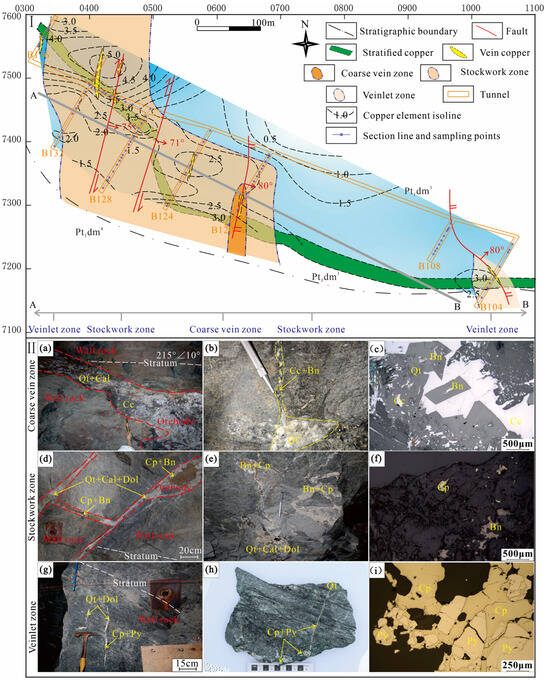
Figure 7.
I. The 140-level Cu anomaly and hydrothermal superposition alteration plane zoning map. II. Macroscopic and microscopic photographs of each alteration zone: (a) coarse vein zone 280-B126 massive chalcocite; (b) coarse vein zone 280-B126 vein chalcocite, bornite, and quartz; (c) coarse vein zone 280-B126 granular chalcocite and bornite; (d) stockwork zone DM-206 vein chalcopyrite, bornite and network vein carbonate, and quartz vein; (e) carbonation and massive-vein bornite-chalcopyrite in the stockwork zone DQ-8; (f) DG-156 carbonate-quartz veins, bornite, and chalcopyrite in the stockwork zone; (g) veinlet zone DM-4 star-shaped chalcopyrite-pyrite; (h) veinlet zone DM-4 quartz-vein chalcopyrite and pyrite; (i) veinlet zone DM-225 allotriomorphic granular pyrite and granular chalcopyrite. (Cp = chalcopyrite; Bn = bornite; Py = pyrite; Cc = chalcocite; Qt = quartz; Cal = calcite; Dol = dolomite).
5.2. Mechanism of Mineralization–Alteration
5.2.1. Fluid Inclusion Results
The fluid inclusions of 10 samples were completed in the experiment, with 133 data points. The inclusions in quartz from the Dahongshan Fe–Cu deposit during hydrothermal superimposition can be divided into liquid (type I), gas–liquid (type II), and daughter mineral-bearing (type III) inclusions. The inclusions are typically less than 9 μm in size, most of which are between 3 μm and 6 μm. Their shapes are primarily circular or long strips, and the gas–liquid ratio is generally less than 10% (Figure 8a,b).
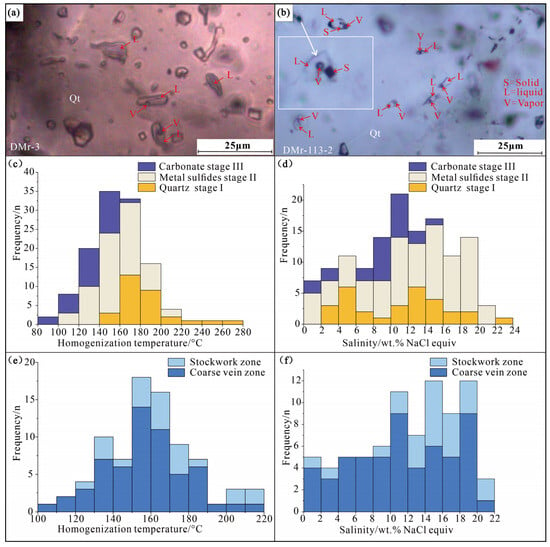
Figure 8.
Microphotographs and homogenization temperature–salinity histograms of fluid inclusions in the Dahongshan vein-like orebodies: (a,b) fluid inclusion types; (c,d) homogenization temperature and salinity histograms at different stages; (e,f) homogenization temperature and salinity histograms of different alteration zones in the Cu sulfide stage (II).
The quartz veins stage (I) of the hydrothermal superposition period: the range of the temperature distribution was 149.2~275.1 °C, the average temperature was 185.0 °C, the range of the salinity distribution was 2.2~23.1 wt% NaCleqv, and the average salinity was 10.8 wt% NaCeqv. The metal sulfides stage (II): the range of the temperature distribution was 101.6~216.1 °C, the average temperature was 159.9 °C, the range of the salinity distribution was 0.2~21.2 wt% NaCleqv, and the average salinity was 12.2 wt% NaCleqv. Carbonate vein stage (III): the range of the temperature distribution was 92.3~164.2 °C, the average temperature was 132.9 °C, the range of the salinity distribution was 0.4~15.47 wt% NaCleqv, and the average salinity was 8.7 wt% NaCleqv. The temperature and salinity decreased from stage I to stage III (Figure 8c,d). The homogenization temperature of the fluid inclusions (Table 3) in the layered ore studied by predecessors (see References) is significantly higher than that of the vein ore that formed during the hydrothermal superposition period. In the hydrothermal superposition period, the fluid was medium–low temperature and medium salinity, but no significant changes occurred in the temperature and salinity in the different alteration zones (Figure 8e,f). Temperature and salinity may not be the primary controlling factors for mineral zoning.

Table 3.
Microthermometry results for the H2O-NaCL fluid inclusions from Dahongshan.
5.2.2. Rare Earth Elements Results
The rare earth element contents in the vein-type ore-bearing whole rock of the Dahongshan Fe–Cu deposit during the hydrothermal superposition period are low (Figure 9 and Table 4). The total rare earth element content is 3.58 × 10−6~174.21 × 10−6 (avg. 96.14 × 10−6), which is right-leaning (LREE/HREE = 1~5.48), with light rare earth enrichment [,,,]. Because Eu and Ce anomalies are primarily related to the oxidation–reduction of water–rock reactions, their anomalies can indicate environmental changes []. The Ce anomaly in the ore-bearing veins of the Dahongshan hydrothermal superposition period did not change significantly, showing weak negative anomalies, whereas the Eu value showed an evolution from clear negative anomalies, weak anomalies, or no anomalies to positive anomalies, indicating changes in the ore-forming redox environment []. Dahongshan shows light rare earth enrichment with a negative Eu anomaly, relatively flat type, and light rare earth enrichment with a positive Eu anomaly (δEu = 0.70~3.49). In general, the Ce anomaly is weak (δCe = 0.70~0.91). The coarse vein zone in the mineral body of the Dahongshan hydrothermal superposition period has an obvious δEu negative anomaly (δEu = 0.70~0.81) and δCe negative anomaly (δCe = 0.70~0.84), indicating that it is a reducing environment. No apparent δEu and weak δCe negative anomalies (δCe = 0.90~0.91) occur in the vein belt. The veinlet zone has a positive anomaly δEu (δEu = 1.27~3.49) and a negative δCe anomaly (δCe = 0.82~0.87). However, the veinlet zone is relatively weak under reduction conditions, and the reaction from the coarse vein to the veinlet zones changes from reduction to weak reduction.
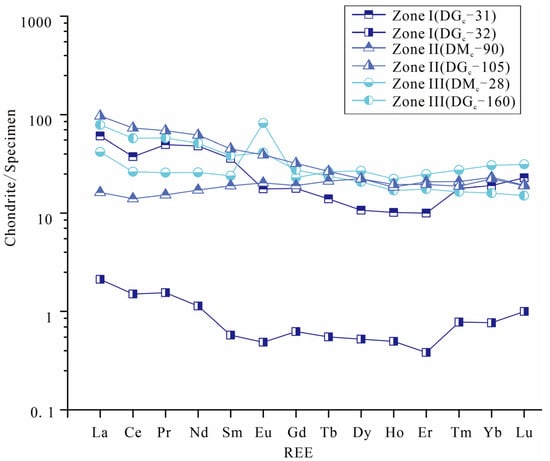
Figure 9.
The distribution pattern of rare earth elements in the whole rock of the Dahongshan hydrothermal superposition period.

Table 4.
Trace elements (10−6) of typical vein orebodies during the Dahongshan hydrothermal superposition period.
6. Discussion
At present, two characteristics of hydrothermal iron-oxide–copper–gold (IOCG) deposits are recognized: variable valence elements and mineralization combinations occur in the redox site []. Magnetite, hematite, Cu minerals, and gold formed during the metamorphic period in the Dahongshan deposit are also hosted in the redox sites. Among them, magnetite is frequently replaced by hematite, but both minerals are enveloped by albite. Native gold is found enclosed within chalcopyrite [].
Wang et al. (2020) [] and Yang et al. (2020) [] conducted detailed studies of magnetite using EPMA. Specifically, in the V + Ti vs. Ca + Al + Mn discriminate diagram used by Chen et al. (2015) (Figure 10) [] model reference [,], the Dahongshan and IOCG deposits exhibit significant similarities [,,,,]. For example, the Dahongshan deposit contains many Fe oxides [], experiences extensive hydrothermal alteration, and has an unclear relationship between mineralization and intrusive rocks []. It exhibits numerous breccias and hydrothermal veins, with widespread Na, K, Ca, and other alterations in the surrounding rock [,,]. Cobalt and nickel are relatively enriched metals in the deposit []. However, its associated gold grade is lower than in typical IOCG deposits []. Special layered and vertically dispersed vein orebodies, which are rare in other IOCG deposits, are common in the region [].
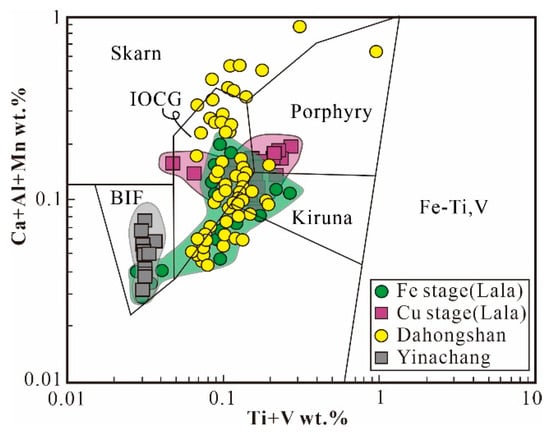
Figure 10.
(a) Plots of the Ca + Al + Mn vs. Ti + V of magnetite from the Dahongshan, Lala, and Yinachang deposits (from Chen et al. (2015) []).
The mineralization–alteration zoning model of the vein orebody in the hydrothermal superposition period of the Dahongshan deposit was constructed based on the geological characteristics of the deposit, the occurrence, and zoning characteristics of the hydrothermal vein ore. The structure strictly controls the orebodies in the hydrothermal superposition period, and the alteration around them has clear zoning characteristics. From the core of the Dibadu anticline to the flank, as follows, it is the coarse vein zone: Cc + Bn + (native copper) + Qt + Cal; the bornite (chalcocite) copper deposit is vein–massive in the fault zone or joint vein; the network vein zone: Bn + Cp + Cal + Dol +Qt + Chl, and Cu ores are often surrounded by chlorite carbonate quartz veins and produced in the fault zone or joint; and the veinlet zone: Cp + (Py) + Dol, small amounts of star-fine vein chalcopyrite and pyrite are observed (Figure 11).
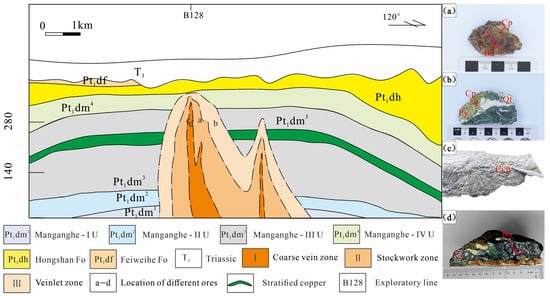
Figure 11.
Dahongshan mining area hydrothermal superimposed period alteration zoning profile. (a) chalcopyrite and bornite; (b) chalcopyrite and pyrite; (c) native copper; (d) bornite and chalcocite. (Cp = chalcopyrite; Bn = bornite; Py = pyrite; Cc = chalcocite; Ccp= native copper; Qt = quartz).
As examined by previous researchers, the homogenization temperature of fluid inclusions in layered orebodies (mineralization) is evidently higher than that observed in the vein orebodies (mineralization) formed during the hydrothermal superposition period. The fluid inclusions are characterized by high temperature and salinity [,], which is true for this type of deposit worldwide and for the study of this particular deposit [,,]. In this study, vein ore in the hydrothermal superposition period was studied, and the fluid showed medium–low temperature and medium salinity characteristics.
Regarding rare earth elements, as early as the last century, some scholars have studied apatite and other minerals in this type of deposit [,,], but detailed research has been conducted in the past 15 years, particularly regarding early potassic, sodium, and calcification [,,,,]. The early layered ore is rich in light rare earth elements, and the slope is very high [,,,,], which differs from the slight light rare earth enrichment mode of the hydrothermal stacking device investigated in this study. The δEu anomalies in the different alteration zones during the hydrothermal superposition period could reflect different redox conditions.
Zhang et al. (2013) [] studied the mineral Cu2S → Cu5FeS4 → CuFeS2→ FeS2 and found that it changed from an alkaline environment to an acidic environment. The mineral assemblage zoning from the core to the flank of the Dibadu anticline in the Dahongshan hydrothermal superposition period is chalcocite + bornite + (native copper) → bornite + chalcopyrite → chalcopyrite + pyrite, indicating that the mineral formation environment changed from strong reduction to weak oxidation. Quartz represents an acidic environment, whereas calcite dolomite represents an alkaline environment, and Cu sulfides are formed in this transitional range, indicating an acidic to alkaline environment from the core to the flank of the Dibadu anticline.
The quartz coarse veins at levels 140 and 60 in the anticline core extend deeper. On the basis of the actual catalog data, the zoning pattern we identified also extends to the deeper sections, strongly supporting the validity of this zoning pattern and serving as a guide for identifying the orientation of deep alteration zones.
7. Conclusions
- (1)
- The hydrothermal superimposition period primarily formed sulfide-type Cu and Fe metal minerals; vein-type bornite, chalcopyrite, chalcocite, pyrite, and native copper, and the mineralization-related alterations were carbonation, silicification, and chloritization. The formation of the core of the Dibadu anticline to the flank of the surrounding rock metal mineral zoning was as follows: Cc + Bn + (Ccp)→ Bn + Cp→ Cp + Py. The mineral zoning was under the dual control of pH and Eh.
- (2)
- The Dahongshan hydrothermal superimposed alteration zoning can be divided into three zones. The coarse vein zone (I) was mineralized into chalcocite, bornite, and a small amount of native copper, and the alteration was primarily vein silicification and a small amount of calcite. The stockwork zone (II) was mineralized as bornite and chalcopyrite, and the alteration comprised calcite-dolomite-quartz veins and chlorite. The veinlet zone (III) was mineralized into chalcopyrite and pyrite and altered into carbonation (dolomite) and silicification. The alteration combination of Qt + Cal (Dol) + Chl during the hydrothermal superposition period is favorable for mineralization.
- (3)
- On the basis of the observed extension of quartz veins within the core of the anticline and the prominent characteristics exhibited by the mineralized alteration zone across various planes, it can be inferred that the deep mineralized alteration zone extends in a southeast direction.
Author Contributions
Conceptualization, X.M. and R.H.; data curation, H.G.; formal analysis, W.Q. and X.M.; funding acquisition, R.H.; investigation, X.K. and Y.Z.; project administration, L.M.; supervision, R.H. and L.S.; writing—original draft, X.M.; writing—review and editing, R.H. and D.Z. All authors have read and agreed to the published version of the manuscript.
Funding
This study obtained funding for prospecting prediction research from the Department of Family Planning of Dahongshan, polymetallic metallogenic system (YXKY-JSGLB-08-(2022)210); for the ore-controlling mechanism and prospecting direction of the ”layer-vein” mineral body structure of the Dahongshan copper–iron polymetallic deposit in Central Yunnan (202301AU070063); the Fund for Mineral Resources Prediction and Evaluation Engineering Laboratory of Yunnan Province in China (2010); and the Fund for the Innovation Team of Yunnan Province in China (2012), Yunnan Provincial EUniversity and Kunming University of Science and Technology Innovation Team of Metallogenic Dynamics and Concealed Ore Prediction.
Data Availability Statement
Data are contained within the article.
Conflicts of Interest
Liuqing Meng and Long Sun are employees of Yuxi Mining Co., Ltd. (Yuxi, China), this paper reflects the views of the scientists and not the company.
References
- Pan, G.T.; Xiao, Q.H.; Lu, S.N.; Deng, J.F.; Feng, Y.M.; Zhang, K.X.; Zhang, Z.Y.; Wang, F.G.; Xing, G.F.; Hao, G.J.; et al. Subdivision of tectonic units in China. Geology 2009, 36, 1–16, (In Chinese with English Abstract). [Google Scholar]
- Deng, J.; Hou, Z.Q.; Mo, X.X.; Yang, L.Q.; Wang, Q.F.; Wang, C.M. Superimposed orogenesis and metallogenesis in Sanjiang Tethys. Acta Petrol. Sin. 2010, 29, 37–42, (In Chinese with English Abstract). [Google Scholar]
- Mao, J.W.; Chen, M.H.; Yuan, S.D.; Guo, C.L. Geological Characteristics of the Qinhang (or Shihang) Metallogenic Belt in South Chinaand Spatial-Temporal Distribution Regularity of Mineral Deposits. Acta Geol. Sin. 2011, 85, 636–658, (In Chinese with English Abstract). [Google Scholar]
- Han, R.S. A preliminary discussion on the typical metallogenic system of polymetallic deposits in the southwest margin of the Yangtze Block. Yunnan. Acta Mineral. Sin. 2013, 33, 905–906. (In Chinese) [Google Scholar]
- Wang, S.W.; Jiang, X.F.; Yang, B.; Sun, X.M.; Liao, Z.W.; Zhou, Q.; Guo, Y.; Wang, Z.Z.; Yang, B. The Proterozoic Tectonic Movement in Kangdian Area I: Kunyang Intracontinental Rift, Mantle Plume and Its Metallogenesis. Geol. Rev. 2016, 62, 1353–1377, (In Chinese with English Abstract). [Google Scholar]
- Li, W.C.; Jiang, X.J. The Cenozoic tectono magmatism-mineralization effect of the intracontinental tectonic transformation System in the western margin of Yangtze Block. Earth Sci. Front. 2020, 27, 151–164, (In Chinese with English Abstract). [Google Scholar]
- Zhao, X.F.; Zhou, M.F. Fe–Cu deposits in the Kangdian region, SW China: A Proterozoic IOCG (iron-oxide–copper–gold) metallogenic province. Miner. Depos. 2011, 46, 731–747. [Google Scholar] [CrossRef]
- Zhao, X.F.; Zhou, M.F.; Su, Z.K.; Li, X.C.; Chen, W.T.; Li, J.W. Geology, Geochronology, and Geochemistry of the Dahongshan Fe-Cu-(Au-Ag) Deposit, Southwest China: Implications for the Formation of Iron Oxide Copper-Gold Deposits in Intracratonic Rift Settings. Econ. Geol. 2017, 112, 603–628. [Google Scholar] [CrossRef]
- Zhao, X.F.; Zhou, M.F.; Li, J.W.; Selby, D.; Li, X.H.; Qi, L. Sulfide Re-Os and Rb-Sr isotope dating of the Kangdian IOCG metallogenic province, southwest China: Implications for regional metallogenesis. Econ. Geol. 2013, 108, 1489–1498. [Google Scholar] [CrossRef]
- Qian, J.H.; Shen, Y.R. Dahongshan Ancient Volcanic Iron Copper Deposit in Yunnan Province; Geology Press: Beijing, China, 1981; pp. 1–336, (In Chinese with English Abstract). [Google Scholar]
- Wu, K.W.; Zhong, H.; Zhu, W.G.; Leng, C.B.; Gou, T.Z. Study on ore-forming fluid of Dahongshan stratified copper deposit in Yunnan Province. Acta Petrol. Sin. 2008, 38, 30–52, (In Chinese with English Abstract). [Google Scholar]
- Zhou, J.Y. The Geochemical Characteristics and Continental Geodynamics of LaLa Copper Deposit; Chengdu University of Technology: Chengdu, China, 2008; pp. 1–129, (In Chinese with English Abstract). [Google Scholar]
- Qin, D.X.; Yang, Y.F.; Tian, Y.L.; Liu, W. Geological characteristics and ore-forming evolution of dahongshan copper deposit. Chin. J. Geol. 2000, 2, 129–139, (In Chinese with English Abstract). [Google Scholar]
- Ye, X.T.; Zhu, W.G.; Zhong, H.; He, D.F.; Ren, T.; Bai, Z.J.; Fan, H.P.; Hu, W.J. Zircon U-Pb and chalcopyrite Re-Os geochronology, REE geochemistry of the Yinachang Fe-Cu-REE deposit in Yunnan Province and its geological significance. Acta Mineral. Sin. 2013, 29, 1167–1186, (In Chinese with English Abstract). [Google Scholar]
- Jin, T.F.; Li, Y.H.; Fei, G.C.; Zhou, H.; Sha, X.B.; Feng, Y.C.; Wu, K. Re-Os Isotopic Dating of Chalcopyrite in Quartz Vein from Dahongshan IOCG Deposit in Kangdian Copper Metallogenic Belt and Its Significance. Acta Mineral. Sin. 2017, 37, 417–426, (In Chinese with English Abstract). [Google Scholar]
- Jin, T.F.; Li, Y.G.; Fei, C.C.; Feng, Y.C.; Zhou, H.; Sha, X.B.; Wu, K. Geochronology of zircon U-Pb from Hongshan Formation in the Dahongshan Group in the Southwest Yangtze Block for the Redefinitions of the Forming Age of the Protolith and Metamorphic Age. Geol. Rev. 2017, 63, 894–910, (In Chinese with English Abstract). [Google Scholar]
- Su, Z.K. Metallogenesis of the Dahongshan Fe-Cu-(Au) Deposit in the Kangdian Region: Constraints from Geochemical and Geochronological Microanalyses; China University of Geosciences: Beijing, China, 2014; pp. 1–238, (In Chinese with English Abstract). [Google Scholar]
- Jin, T.F.; Luo, W.; Li, Y.G.; Li, P.W.; Sun, T.J.; Lan, Y.F. Sm-Nd isotopic dating of calcite in the ore-bearing calcite vein from the Dahongshan iron copper polymetallic deposit in the southwestern margin of Yangtze block and its significance. Acta Mineral. Sin. 2021, 41, 343–354, (In Chinese with English Abstract). [Google Scholar]
- Xavier, R.P.; Wiedenbeck, M.; Trumbull, R.B.; Dreher, A.M.; Monteiro, L.V.S.; Rhede, D.; de Araujo, C.E.G.; Torresi, I. Tourmaline B-isotopes fingerprint marine evaporites as the source of high-salinity ore fluids in iron oxide copper-gold deposits, Carajas Mineral Province (Brazil). Geology 2008, 36, 743–746. [Google Scholar] [CrossRef]
- Chen, W.T.; Zhou, M.F.; Zhao, X.F. Late Paleoproterozoic sedimentary and mafic rocks in the Hekou area, SW China: Implication for the reconstruction of the Yangtze Block in Columbia. Precambrian Res. 2013, 231, 61–77. [Google Scholar] [CrossRef]
- Barton, M.D. Iron oxide(-Cu-Au-REE-P-Ag-U-Co) systems. Treatise Geochem. 2014, 13, 515–541. [Google Scholar]
- Brian, R. Exploring for Iron Oxide Copper-Gold Deposits: Canada and Global Analogues. Geological Association of Canada Short Course Notes 20. Econ. Geol. 2012, 107, 1077. [Google Scholar]
- Groves, D.I.; Bierlein, F.P.; Meinert, L.D.; Hitzman, M.W. Iron Oxide Copper-Gold (IOCG) Deposits through Earth History: Implications for Origin, Lithospheric Setting, and Distinction from Other Epigenetic Iron Oxide Deposits. Ecol. Geol. 2010, 105, 641–654. [Google Scholar] [CrossRef]
- Fang, W.X. Geotectonic Evolution and the Proterozoic lron Oxide Copper-Gold Deposits on the Western Margin of the Yangtze Massif. Geotecton. Metallog. 2014, 38, 733–757, (In Chinese with English Abstract). [Google Scholar]
- Fang, W.X.; Yang, X.Y.; Guo, M.H.; Liu, Y.L. Relationships between Alkaline Ti-Fe-Rich Gabbros and lron-Oxide Copper-Gold Deposits in the Baixila Ore District & Yunnan. Geotecton. Metallog. 2013, 38, 733–757, (In Chinese with English Abstract). [Google Scholar]
- Song, H. Precambrian Copper-Iron-Gold-Uranium Polymetallic Deposits and Their Regional Metallogeny in Southwestern Margin of Yangtze Block; Chengdu University of Technology: Chengdu, China, 2014; pp. 1–217, (In Chinese with English Abstract). [Google Scholar]
- Li, Z.Q.; Hu, R.Z.; Wang, J.Z.; Liu, J.J.; Li, C.Y.; Liu, Y.P.; Ye, L. Lala Fe-Oxide-Cu-Au-U-REE Ore Deposit, Sichuan China—An Example of Superimposed Mineralization. Bull. Mineral. Petrol. Geochem. 2002, 4, 258–260, (In Chinese with English Abstract). [Google Scholar]
- Fang, W.X.; Liu, Y.L.; Zhang, S.L.; Guo, M.H. Three types of continental geodynamics and metallogenic models for lOCG (lron-oxide Copper Gold Deposits) from the global view. J. Northwest Univ. (Nat. Sci. Ed.) 2009, 39, 404–413, (In Chinese with English Abstract). [Google Scholar]
- Yang, Y.M.; Tu, G.Z.; Hu, R.Z. REE Geochemistry of Yinachang Fe-Cu-REE Deposit in Yunnan Province. Acta Mineral. Sin. 2004, 4, 301–308, (In Chinese with English Abstract). [Google Scholar]
- Hou, L.; Peng, H.J.; Ding, J. Sources of the ore-forming materials for the Yinachang Fe-Cu-Au-REE deposit, Wuding. Yunnan Province: Constraints from the ore geology and the S, Pb, H, O isotope geochemistry. Acta Petrol. Mineral. 2015, 34, 205–218, (In Chinese with English Abstract). [Google Scholar]
- Huang, C.J. Geology and Geochemistry Study on the Lala IOCG Deposit Southwestern Margin of Yangtze Block; Chengdu University of Technology: Chengdu, China, 2019; pp. 1–273, (In Chinese with English Abstract). [Google Scholar]
- Gao, F. Early to Middle Neoproterozoic Tectonic Evolution of the Northwestern Margin of the Northwestern Margin of the Yangtze Block: Evidence from the Hengdan Group Sdimentary Strata; Chang’an University: Xi’an, China, 2020; pp. 1–174, (In Chinese with English Abstract). [Google Scholar]
- Li, T.D.; Liu, Y.; Ding, X.Z.; Pang, J.F. The advances in regional geological research of China in recent years. Acta Geol. Sin. 2020, 96, 1544–1581, (In Chinese with English Abstract). [Google Scholar]
- Wu, M.D.; Li, X.J. Two types of diapiric structure of the Kunyang Group, Yunnan. Acta Geol. Sin. 1981, 55, 105–118, (In Chinese with English Abstract). [Google Scholar]
- Yang, G.S.; Mao, Z.B.; Qin, L.J.; Li, Y.G.; Ye, Z.F.; Wang, K.; Zhou, Y. Geochemical Characteristics of Carbon and Oxygen Isotopes and Trace Elements of the Dahongshan Cu-Fe Deposit in Yunnan and Their Metallogenic Significances. Bull. Mineral. Petrol. Geochem. 2020, 39, 945–960, (In Chinese with English Abstract). [Google Scholar]
- Sun, J.C.; Han, R.S. The Theory and Method of Orefield Geomechanics; Science Press: Beijing, China, 2016; pp. 1–356. (In Chinese) [Google Scholar]
- Sun, J.C. Analysis of the Structural Type of Controlled Orein Dahongshan Iron Mining Area, Yunnan. J. Geomech. 1984, 10, 45–55, (In Chinese with English Abstract). [Google Scholar]
- Ye, Z.F.; Yang, G.S.; Qin, L.J.; Chen, A.B.; Wang, K.; Zhou, Y.; Mao, Z.B.; Dai, Z.H. Restoration of the ore-bearing metamorphic rocks and its formation environment in the Dahongshan iron-copper deposit, Yunnan Province. Acta Petrol. Mineral. 2021, 40, 429–451, (In Chinese with English Abstract). [Google Scholar]
- Ye, Z.F.; Yang, G.S.; Qin, L.J.; Chen, A.B.; Zheng, X.J.; Wang, M.J. Characteristics and geological significances of the garnets in the Dahongshan iron-copper deposit, Yunnan, China. Acta Mineral. Sin. 2022, 42, 461–477, (In Chinese with English Abstract). [Google Scholar]
- Han, R.S. Orefied/deposit tectono-geochemical method for the localization and prognosis of concealed orebodies. Geol. Bull. China 2005, 14, 104–110, (In Chinese with English Abstract). [Google Scholar]
- Bodnar, R.J. Revised equation and table for determining the freezing point depression of H2O-NaCl solutions. Geochim. Cosmochim. Acta 1993, 57, 683–684. [Google Scholar] [CrossRef]
- Qi, L.; Hu, J.; Gregoire, D.C. Determination of trace elements in granites by inductively coupled plasma mass spectrometry. Talanta 2000, 51, 507–513. [Google Scholar]
- Gong, H.S.; Han, R.S.; Li, Z.T.; Ren, T.; Wang, J.S.; Chen, G. Element association anomaly of tectonites and prediction of concealed deposit in the Xiaozhuqing exploration area on the periphery of Huize lead-zinc mine area, northeastern Yunnan Province. J. Geomech. 2020, 26, 419–431, (In Chinese with English Abstract). [Google Scholar]
- Mathieu, L. Quantifying Hydrothermal Alteration: A Review of Methods. Geosciences 2018, 8, 245. [Google Scholar] [CrossRef]
- Han, R.S.; Wang, L.; Fang, W.X.; Huang, J.G.; Feng, W.J.; Hu, Y.D. The preliminary discussion on diapir structure-lithofacies zonation model for the Fengshan copper deposit, Yimen area, Yunnan, China. Geol. Bull. China 2011, 30, 495–504, (In Chinese with English Abstract). [Google Scholar]
- Zhao, D.; Han, R.S.; Ren, T.; Wang, J.S.; Zhang, X.P.; Wu, Y.T.; Cui, J.H. The Mineralization and Alteration Zoning of the Le hong Lead Zinc Deposit, the Large Deposit Concentration Area in the Northeast of Yunnan Province, China. Bull. Mineral. Petrol. Geochem. 2016, 35, 1258–1269, (In Chinese with English Abstract). [Google Scholar]
- Tao, Q.; Han, R.S.; Zhao, D.; Wu, P.; Tian, X.F.; Zhao, T.C.; Yang, H.; Zong, Z.H.; Deng, A.P. The mineralization and alteration zoning model related to the concealed granite porphyry of the Huangshaping Cu-Sn polymetallic deposit, Southern Hunan Province. Geol. China 2020, 50, 586–604, (In Chinese with English Abstract). [Google Scholar]
- Yuan, H.; Han, R.S.; Feng, Z.X.; Wu, P.; Guan, S.J.; Ding, T.Z.; Li, L.J.; Yang, B. Mineralization-alteration zoning law and element compositional zoning pattern in mineralized altered rocks from the Daliangzi Pb-Zn deposit, southwestern Sichuan. J. Geomech. 2022, 42, 461–477, (In Chinese with English Abstract). [Google Scholar]
- Zhang, X.P.; Han, R.S.; Zhao, D.; Zhang, Y.; Qiu, W.L.; He, J.J.; Cui, J.H. Quantitative analysis of mineralization-alteration index and deep prospecting significance of Qilinchang Pb-Zn deposit in Huize, northeastern Yunnan. Geol. Bull. China 2022, 41, 1445–1461, (In Chinese with English Abstract). [Google Scholar]
- Zeng, S.M.; Han, R.S.; Zhang, Y.; Liu, F.; Wang, M.Z.; WU, Z.Z.; Tian, Y.T. Zonation of hydrothermal alteration and migration of elements in the Wengkongba copper-polymetallic deposit, southwestern Yunnan. Geol. Bull. China 2023, 69, 1184–1207, (In Chinese with English Abstract). [Google Scholar]
- Deng, M.G. The Iron and Copper Poly-Metal Metallogenic Series and Minerogenetic Targeting of Xinping Dahongshan-Yuanjiang Cuoke Area; Kunming University of Science and Technology: Kunming, China, 2007; pp. 1–204, (In Chinese with English Abstract). [Google Scholar]
- Zhang, M.Y.; Zhang, Y.X. Study on geochemical characteristics of rare earth elements in Dahongshan copper deposit. Earth Environ. 1996, 5, 15–17. (In Chinese) [Google Scholar]
- Ding, Z.J.; Liu, C.Q.; Yao, S.Z.; Zhou, Z.G. REE composition and implication of hydrothermal sedimentation of sea-floor. Bull. Geol. Sci. Technol. 2000, 19, 27–30+34, (In Chinese with English Abstract). [Google Scholar]
- Liang, T.; Wang, D.H.; Qu, W.J.; Cai, M.H.; Wei, K.L.; Huang, H.M.; Wu, D.C. REE geochemistry of calcites in the Dachang tin-polymetanic deposit, Guangxi. Acta Petrol. 2007, 23, 2493–2503, (In Chinese with English Abstract). [Google Scholar]
- Ye, T.Z.; Lv, Z.C.; Pang, Z.S.; Zhang, D.H.; Liu, S.Y.; Wang, Q.M.; Liu, J.J.; Cheng, Z.Z.; Li, C.L.; Xiao, K.Y.; et al. Theory and Method of Prospecting Prediction in Prospecting Area (General); Geology Press: Beijing, China, 2014; pp. 1–703. (In Chinese) [Google Scholar]
- Su, Z.-K.; Zhao, X.-F.; Li, X.-C.; Zhou, M.-F. Using elemental and boron isotopic compositions of tourmaline to trace fluid evolutions of IOCG systems: The worldclass Dahongshan FeCu deposit in SW China. Chem. Geol. 2016, 441, 265–279. [Google Scholar] [CrossRef]
- Wang, Y.J.; Zhu, W.G.; Huang, H.-Q.; Bai, Z.-J.; Zhong, H.; Yao, J.-H.; Fan, H.-P. Geochemistry of magnetite from the giant Paleoproterozoic Dahongshan Fe-Cu deposit, SW China: Constraints on nature of ore-forming fluids and depositional setting. Ore Geol. Rev. 2020, 118, 103361. [Google Scholar] [CrossRef]
- Chen, W.T.; Zhou, M.F.; Gao, J.F.; Hu, R.Z. Geochemistry of magnetite from Proterozoic Fe-Cu deposits in the Kangdian metallogenic province, SW China. Miner. Depos. 2015, 50, 795–809. [Google Scholar] [CrossRef]
- Nadoll, P.; Angerer, T.; Mauk, J.L.; French, D.; Walshe, J. The chemistry of hydrothermal magnetite: A review. Ore Geol. Rev. 2014, 61, 1–32. [Google Scholar] [CrossRef]
- Dupuis, C.; Beaudoin, G. Discriminant diagrams for iron oxide trace element fingerprinting of mineral deposit types. Miner. Depos. 2011, 46, 319–335. [Google Scholar] [CrossRef]
- Bastrakov, E.N.; Skirrow, R.G.; Davidson, G.J. Fluid evolution and origins of Iron oxide CuAu prospects in the Olympic Dam District, Gawler Craton, South Australia. Econ. Geol. 2007, 102, 1415–1440. [Google Scholar] [CrossRef]
- Barton, M.D.; Johnson, D.A. Evaporitic-source model for igneous related Fe-oxide (REE–Cu–Au) mineralization. Geology 1996, 24, 259–262. [Google Scholar] [CrossRef]
- Barton, M.D.; Johnson, D.A. Alternative brine sources for Fe-oxide(-Cu-Au) systems: Implications for hydrothermal alteration and metals. In Hydrothermal Iron Oxide Copper-Gold & Related Deposits: A Global Perspective; Porter, T.M., Ed.; Australian Mineral Foundation: Glenside, Australia, 2000; Volume 1, pp. 43–60. [Google Scholar]
- Hitzman, M.W.; Oreskes, N.; Einaudi, M.T. Geological characteristics and tectonic setting of proterozoic iron oxide (Cu-U-Au-REE) deposits. Precambrian Res. 1992, 58, 241–287. [Google Scholar] [CrossRef]
- Williams, P.J.; Barton, M.D.; Johnson, D.A.; Fontbote, L.; Haller, A.; Geordie, M.; Oliver, N.H.S. Iron Oxide Copper-Gold Deposits: Geology, Space-Time Distribution, and Possible Modes of Origin. Econ. Geol. 2005, 100, 371–405. [Google Scholar]
- Meinert, L. Hydrothermal Iron Oxide Copper-Gold and Related Deposits: A Global Perspective. Econ. Geol. 2001, 96, 1311–1312. [Google Scholar] [CrossRef]
- Pollard, P.J. An intrusion-related origin for Cu–Au mineralization in iron oxide–copper–gold (IOCG) provinces. Miner. Depos. 2006, 41, 179–187. [Google Scholar] [CrossRef]
- Moreto, C.P.N.; Monteiro, L.V.S.; Xavier, R.P.; Creaser, R.A.; DuFrane, A.; Melo, G.H.C.; Silva, M.A.D.; Tassinari, C.C.G.; Sato, K. Timing of multiple hydrothermal events in the iron oxide–copper–gold deposits of the Southern Copper Belt, Carajás Province, Brazil. Miner. Depos. 2015, 50, 517–546. [Google Scholar] [CrossRef]
- Pollard, P.J.; Mark, G.; Mitchell, L.C. Geochemistry of post-1540 ma granites in the Cloncurry district, Northwest Queensland. Econ. Geol. 1998, 93, 1330–1334. [Google Scholar] [CrossRef]
- Barton, M.D.; Jensen, E.P.; Ducea, M. Fluid sources for IOCG (Candelaria, punta del Cobre) and porphyry Cu-style mineralization, Copiapó batholith, Chile: Geologic and Sr isotopic constraints. Geol. Soc. Am. Abst. Prog. 2005, 37, 316. [Google Scholar]
- Monteiro, L.V.S.; Xavier, R.P.; Hitzman, M.W.; Juliani, C.; Souza Filho, C.R.; Carvalho, E.R. Mineral chemistry of ore and hydrothermal alteration at the Sossego iron oxide–copper–gold deposit, Carajás Mineral Province, Brazil. Ore Geol. Rev. 2008, 34, 317–336. [Google Scholar] [CrossRef]
- Yang, G.S.; Yan, Y.F.; Wen, H.J.; Hu, R.Z.; Zhang, J.W. IOCG mineralization and its characteristics in the southwestern margin of the Yangtze block. Acta Mineral. Sin. 2015, 35, 252–253. (In Chinese) [Google Scholar]
- Su, Z.K.; Zhao, X.F.; Wang, C.Y. Trace elements and sulfur isotopic compositions of sulfides in the giant Dahongshan Fe-Cu-(Au-Co) deposit, SW China: Implications for fluid evolution and Co enrichment in IOCG systems. Ore Geol. Rev. 2023, 157, 105401. [Google Scholar] [CrossRef]
- Fuentes, G.E.; Camprubi, A.; Gonzalez, P.E.; Hernandez, A.G.; Alfonso, P.; Cienfuegos, A.E.; Mesino, H.J.C.; Ortega, O.C.; Otero, T.F.J.; Ramirez, J.T.V. The Tatatila–Las Minas IOCG skarn (Veracruz, Mexico): Mineralogical, fluid inclusion and stable isotope constraints. J. S. Am. Earth Sci. 2023, 122, 104112. [Google Scholar] [CrossRef]
- Gustavo, S.C.; Raimundo, N.N.V.; Roberto, P.X. A fluid inclusion and stable isotope (O, H, S and C) study of the Archean IOCG Cristalino deposit, Carajás mineral Province, Brazil: Implications to ore genesis. Ore Geol. Rev. 2020, 127, 103822. [Google Scholar]
- Schandl, E.S.; Gorton, M.P. The Scadding gold mine, east of the Sudbury igneous complex, Ontario: An IOCG-type deposit? Can. Mineral. 2007, 45, 1415–1441. [Google Scholar] [CrossRef]
- Hunt, J.A.; Baker, T.; Cleverley, J.; Davidson, G.J.; Fallick, A.E.; Thorkelson, D.J.; Harris, A. Fluid inclusion and stable isotope constraints on the origin of Wernecke Breccia and associated iron oxide-copper-gold mineralization, Yukon. Can. J. Earth Sci. 2011, 48, 1425–1445. [Google Scholar] [CrossRef]
- Frietsch, R.; Perdahl, J.A. Rare earth elements in apatite and magnetite in Kiruna-type iron ores and some other iron ore types. Ore Geol. Rev. 1995, 9, 489–510. [Google Scholar] [CrossRef]
- Pan, Y.M. Oriented, Monazite Inclusions in Apatite Porphyroblasts from the Hemlo Gold Deposit, Ontario, Canada. Mineral. Mag. 1993, 57, 697–707. [Google Scholar] [CrossRef]
- Forster, H.-J.; Harlow, D.E. Monazite-(Ce)–huttonite solid solutions in granulite-facies metabasites from the Ivrea-Verbano Zone, Italy. Mineral Mag. 1999, 63, 587–594. [Google Scholar] [CrossRef]
- Harlov, D.E. High-Grade Fluid Metasomatism on both a Local and a Regional Scale: The Seward Peninsula, Alaska, and the Val Strona di Omegna, Ivrea–Verbano Zone, Northern Italy. Part II: Phosphate Mineral Chemistry. J. Petrol. 2002, 43, 801–824. [Google Scholar] [CrossRef]
- Ziemann, M.A.; Forster, H.-J.; Harlov, D.E.; Frei, D. Origin of fluorapatite–monazite assemblages in a metamorphosed, sillimanite-bearing pegmatoid, Reinbolt Hills, East Antarctica. Eur. J. Mineral. 2005, 17, 567–579. [Google Scholar] [CrossRef]
- Sun, X.; Tang, Q.; Sun, W.; Li, X.; Wei, Z.; Liang, J.; Shen, K.; Zhang, Z.; Bing, Z. Monazite, iron oxide and barite exsolutions in apatite aggregates from CCSD drillhole eclogites and their geological implications. Geochim. Cosmochim. Acta 2007, 71, 2896–2905. [Google Scholar]
- Torab, F.M.; Lehmann, B. Magnetite-apatite deposits of the Bafq district, Central Iran: Apatite geochemistry and monazite geochronology. Mineral. Mag. 2007, 71, 347–363. [Google Scholar] [CrossRef]
- Bonyadi, Z.; Davidson, G.J.; Mehrabi, B.; Meffre, S.; Ghazban, F. Significance of apatite REE depletion and monazite inclusions in the brecciated Se–Chahun iron oxide–apatite deposit, Bafq district, Iran: Insights from paragenesis and geochemistry. Chem. Geol. 2011, 281, 253–269. [Google Scholar] [CrossRef]
- Chen, W.T.; Zhou, M.F. Mineralogical and geochemical constraints on mobilization and mineralization of rare Earth elements in the Lala Fe-Cu-(Mo, Ree) deposit, SW China. Am. J. Sci. 2015, 315, 671–711. [Google Scholar] [CrossRef]
- Mukherjee, R.; Venkatesh, A.S.; Fareeduddin. Geochemical characterization of mineralized albitite from Paleoproterozoic Bhukia IOCG-IOA deposit of Aravalli-Delhi Fold Belt, Rajasthan, western India: Genetic linkage to the gold (±Cu ±U) mineralization. Geol. J. 2020, 55, 4203–4225. [Google Scholar] [CrossRef]
- Montreuil, J.F.; Potter, E.G.; Corriveau, L.; Davis, W.J. Element mobility patterns in magnetite-group IOCG systems: The Fab IOCG system, Northwest Territories, Canada. Ore Geol. Rev. 2016, 72, 562–584. [Google Scholar] [CrossRef]
- Tobias, U.S.; Thomas, W.; Tobias, F. Fluorite as indicator mineral in iron oxide-copper-gold systems: Explaining the IOCG deposit diversity. Chem. Geol. 2020, 548, 119674. [Google Scholar]
- Zhang, Y.; Han, R.S.; Wu, P.; Wei, P.T. Application of Thermodynamic pH-Eh to Mineral Zonation Model of Sandstone-hosted Type Copper Deposits in the Chuxiong Basin, Central Yunnan Province, China. Acta Mineral. Sin. 2013, 33, 363–368, (In Chinese with English Abstract). [Google Scholar]
Disclaimer/Publisher’s Note: The statements, opinions and data contained in all publications are solely those of the individual author(s) and contributor(s) and not of MDPI and/or the editor(s). MDPI and/or the editor(s) disclaim responsibility for any injury to people or property resulting from any ideas, methods, instructions or products referred to in the content. |
© 2024 by the authors. Licensee MDPI, Basel, Switzerland. This article is an open access article distributed under the terms and conditions of the Creative Commons Attribution (CC BY) license (https://creativecommons.org/licenses/by/4.0/).